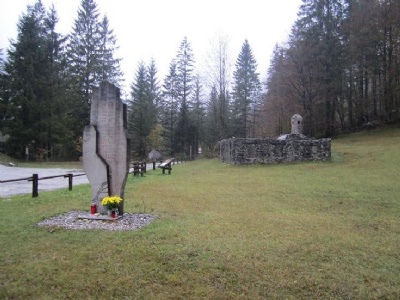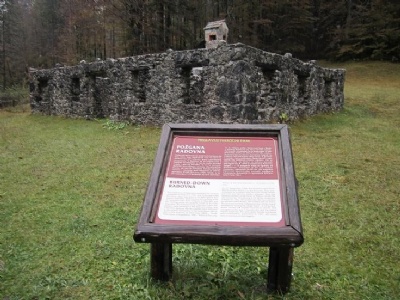Radovna
On September 11, 1944, a German military unit arrived in the village of Radovna to retrieve firewood but were ambushed and two German soldiers were taken prisoner. The next day the Germans returned to the village of Frzkovo and threatened to kill all the inhabitants of Radovna unless the two captured germans were returned within eight days. But no soldiers were returned (they were probably already dead) and the germans returned to Radovna on September 20 and retaliated by burning down the village’s twelve houses. 24 people were burned inisde the houses. The youngest was only seven months old and the oldest 81.
Current status: Demolished with monument (2011).
Location: 46°24'39.98"N 13°59'44.62"E
Get there: Car.
Follow up in books: Hamburg Institute for Social Research: The German Army and Genocide: Crimes Against War Prisoners, Jews, and Other Civilians in the East, 1939-1944 (1999).


The site is located among mountains and small villages linked by small gravel roads and not easy to find. In addition to the monument, the ruins remain after one of the stone houses. The simplicity and privacy of the place is a strength in itself. A simple monument, a small information board and ruins after the house creates something worthy with simple means. Sometimes less is more.
The massacre was carried out by units of the German army (Wehrmacht) and not by SS units. Nowadays there is no longer any doubt that Wehrmacht carried out massacres of civilians, participated together with SS or assisted SS in massacres. But for a long time after the war there was among Wehrmacht circles an interest to distance themselves from war crimes. It was SS who committed these horrific crimes and were to blame, not Wehrmacht. Wehrmacht wanted to spread an image of itself as a mere combatant unit that followed the martial law that existed and did not engage in war crimes.
This was a perception that spread and for a long time there was a perception that it was only the SS who engaged in war crimes. But even though a large part of the Wehrmacht did not commit war crimes to same extent as SS, there were massacres that make them no longer innocent. Wehrmacht was not directly involved in the extermination camps, but they assisted the Nazi Einsatzgruppen and carried out, as in Radovna, retaliation against civilians, particularly in Yugoslavia and the Soviet Union.